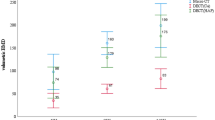Abstract
Objective
To evaluate multidetector CT volumetry in the assessment of bone defect healing in comparison to histopathological findings in an animal model.
Materials and methods
In 16 mini-pigs, a circumscribed tibial bone defect was created. Multidetector CT (MDCT) of the tibia was performed on a 64-row scanner 42 days after the operation. The extent of bone healing was estimated quantitatively by MDCT volumetry using a commercially available software programme (syngo Volume, Siemens, Germany).The volume of the entire defect (including all pixels from −100 to 3,000 HU), the nonconsolidated areas (−100 to 500 HU), and areas of osseous consolidation (500 to 3,000 HU) were assessed and the extent of consolidation was calculated. Histomorphometry served as the reference standard.
Results
The extent of osseous consolidation in MDCT volumetry ranged from 19 to 92% (mean 65.4 ± 18.5%). There was a significant correlation between histologically visible newly formed bone and the extent of osseous consolidation on MDCT volumetry (r = 0.82, P < 0.0001). A significant negative correlation was detected between osseous consolidation on MDCT and histological areas of persisting defect (r = −0.9, P < 0.0001).
Conclusion
MDCT volumetry is a promising tool for noninvasive monitoring of bone healing, showing excellent correlation with histomorphometry.



Similar content being viewed by others
References
Praemer A, Furner S, Rice DP. Musculosceletal conditions in the United States. Park Ridge: American Academy of Orthopaedic Surgeons; 1992.
Hammer RR, Hammerby S, Lindholm B. Accuracy of radiologic assessment of tibial shaft fracture union in humans. Clin Orthop Relat Res. 1985;199:233–8.
Blockhuis TJ, de Bruine JH, Bramer JA, et al. The reliability of plain radiography in experimental fracture healing. Skeletal Radiol. 2001;30:151–6.
Letournel E. Acetabulum fractures: classification and mamagement. Clin Orthop Relat Res. 1980;151:81–106.
Panjabi MM, Lindsey RW, Walter SD, et al. The clinican’s ability to evaluate the strength of healing fractures from plain radiographs. J Orthop Trauma. 1989;3:29–32.
Nicholls PJ, Berg E, Bliven Jr FE, Kling JM. X-ray diagnosis of healing fractures in rabbits. Clin Orthop. 1979;142:234–6.
Schnarkowski P, Rédei J, Peterfy CG, et al. Tibial shaft fractures: assessment of fracture healing with computed tomography. J Comput Assist Tomogr. 1995;19(5):777–81.
Panjabi MM, Walter SD, Karuda M, White AA, Lawson JP. Correlations of radiographic analysis of healing fractures with strength: a statistical analysis of experimental osteotomies. J Orthop Res. 1985;3:212–8.
Morgan EF, Mason ZD, Chien KB, et al. Micro-computed tomography assessment of fracture healing: relationships among callus structure, composition, and mechanical function. Bone. 2009;44:335–44.
Firoozabadi R, Morsher S, Engelke K, et al. Qualitative and quantitative assessment of bone fragilitiy and fracture healing using conventional radiography and advanced imaging technologies-focus on wrist fracture. J Orthop Trauma. 2008;22(8):83–90.
Warwick R, Willatt JM, Singhal B, Borremans J, Meagher T. Comparison of computed tomographic and magnetic resonance imaging in fracture healing after spinal injury. Spinal Cord. 2009;47(12):874–7.
Den Boer FC, Bramer JAM, Patka P, et al. Quantification of fracture healing with three-dimensional computed tomography. Arch Orthop Trauma Surg. 1998;117:345–50.
Augat P, Merk J, Genant HK, Claes L. Quantitative assessment of experimental fracture repair by peripheral computed tomography. Calcif Tissue Int. 1997;60:194–9.
Freeman TA, Patel P, Parvizi J, Antoci Jr V, Shapiro IM. Micro-CT analysis with multiple thresholds allows detection of bone formation and resorption during ultrasound-treated fracture healing. J Orthop Res. 2009;27(5):673–9.
Eley KA, Witherow H, Hayward R, Evans R, Young K, Clark A, et al. The evaluation of bony union after frontofacial distraction. J Craniofac Surg. 2009;20(2):275–8.
Jungbluth P, Wild M, Grassmann JP, Ar E, Sager M, Herten M, et al. Platelet-rich plasma on calcium phosphate granules promotes metaphyseal bone healing in mini-pigs. J Orthop Res. 2010;28(11):1448–55.
Grigoryan M, Lynch JA, Fierlinger AL, et al. Quantitative and qualitative assessment of closed fracture healing using computed tomography and conventional radiography. Acad Radiol. 2003;10:1267–73.
Hakimi M, Jungbluth P, Sager M, Betsch M, Herten M, Becker J, et al. Combined use of platelet-rich plasma and autologous bone grafts in the treatment of long bone defects in mini-pigs. Injury. 2010;41(7):717–23.
Wheeler DL, Cross AR, Eschbach EJ, et al. Grafting of massive ytibial subchondral bone defects in a caprine model using beta-tricalcium phosphate versus autograft. J Orthop Trauma. 2005;19(2):85–91.
Özcelik D, Hüthüt I, Kuran I, Bankaouglu M, Orhan Z, Mayda AS. Comparison of accuracy of three dimensional spiral computed tomography, standard radiography, and direct measurement in evaluating facial fracture healing in a rat model. Ann Plast Surg. 2004;53(5):473–80.
Sarkar MR, Augat P, Shefelbine SJ, et al. Bone formation in a long bone defect model using a platelet-rich plasma-loaded collagen scaffold. Biomaterials. 2006;27:1817–23.
Wiedmer U, Freuler F, Bianchini D. Fracture movement and fracture healing in plaster fixation. Arch Orthop Unfallchir. 1975;82(2):177–81.
Author information
Authors and Affiliations
Corresponding author
Rights and permissions
About this article
Cite this article
Riegger, C., Kröpil, P., Jungbluth, P. et al. Quantitative assessment of bone defect healing by multidetector CT in a pig model. Skeletal Radiol 41, 531–537 (2012). https://doi.org/10.1007/s00256-011-1203-6
Received:
Revised:
Accepted:
Published:
Issue Date:
DOI: https://doi.org/10.1007/s00256-011-1203-6




